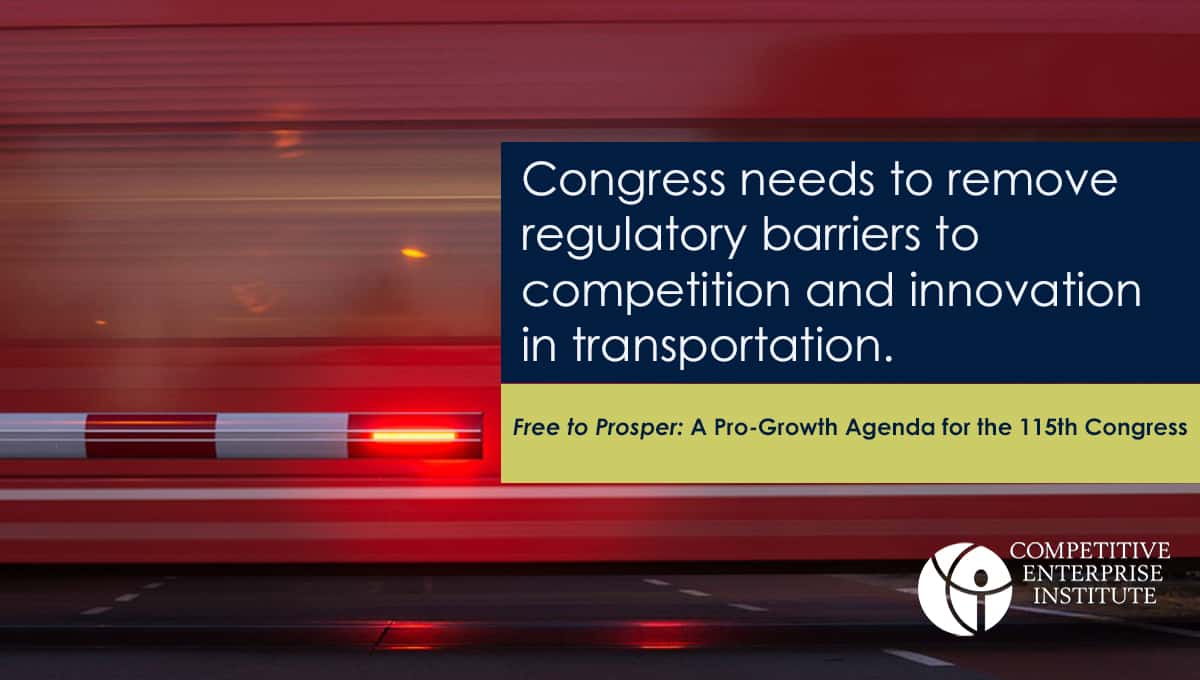Free to Prosper: Transportation
A Pro-Growth Agenda for the 115th Congress

View the full chapter on Transportation here
Mobility is one of our most important needs, one we often take for granted until it is threatened or lost. Reliable movement of both persons and goods depends upon adequate transportation infrastructure investments and management. In the United States, transportation now accounts for nearly 10 percent of gross do-mestic product.
Four million miles of highways enable 3 trillion vehicle-miles traveled every year, according to the Bureau of Transportation Statistics. Nearly 20,000 airports enable almost 10 million annual aircraft departures carrying over 685 million passengers.
More than $12 trillion worth of goods are moved every year in the United States by road, rail, air, and water.
Transportation networks vary greatly in quality, financing, and management. For instance, roads are generally paid for out of user-tax or property-tax revenues, whereas freight rail is privately financed and operated. One important lesson is that the private sector is generally better than government in financing and operating high-quality transportation systems at lower costs. New technologies and management practices present serious challenges going forward, particularly to those networks that exist largely as government monopolies.

Even if privatization of existing networks is politically unattainable, the starting point for sound transportation policy is adherence to the user-pays/user-benefits principle.
Transportation infrastructure and operations should be paid for by those who directly benefit from their use. Despite some spillover effects, the vast majority of benefits accrue to the network users. Compared with general revenue funding of government-owned infrastructure and services, the user-pays principle offers the following advantages:
- Transparency. Unlike tax dollars that wind through convoluted bureaucracies,charges “follow” users.
- Fairness. Users pay and benefit directly from improvements generated from theirpayments; users who use the systems more pay more.
- Signaling investment. Operating revenues generally track use, and popular systems can be identified for targeted improvements.
Unfortunately, many federal transportation programs do not adhere to the user-pays principle. In those cases, the programs should be reformed to meet that principle. If such reform proves impossible or unfeasible, it suggests that the program has a high cost and low value and should be eliminated.
The history of economic regulation of transportation systems in the United States shows that competitive markets benefit consumers more than top-down planning and control. In the late 1970s and early 1980s, airlines, motor carriers, and freight rail were partially deregulated, leading to lower prices and improved service. Today, rules aimed at promoting safety dominate many discussions of transportation regulation. However, although safety regulation was well intended, many of the resulting measures provide few, if any, benefits at very high costs. In a number of cases, safety regulation has become a way to impose backdoor economic regulation, even though explicit economic regulation is now greatly constrained or prohibited by law. That factor should concern policy makers.
To better promote high-value, low-cost mobility, Congress should critically examine current practices and work to remove government barriers to competition and innovation in the transportation sector. The Federal Aviation Administration should be reformed to promote increased airline competition and encourage new innovations in aircraft systems, airspace management, and airport financing. The federal role in surface transportation should be rationalized to allow state and local flexibility while adhering to the user-pays principle.
In this chapter:
- Modernize America’s Air Travel Infrastructure in the Federal Aviation Administration Reauthorization
- Reform Surface Transportation